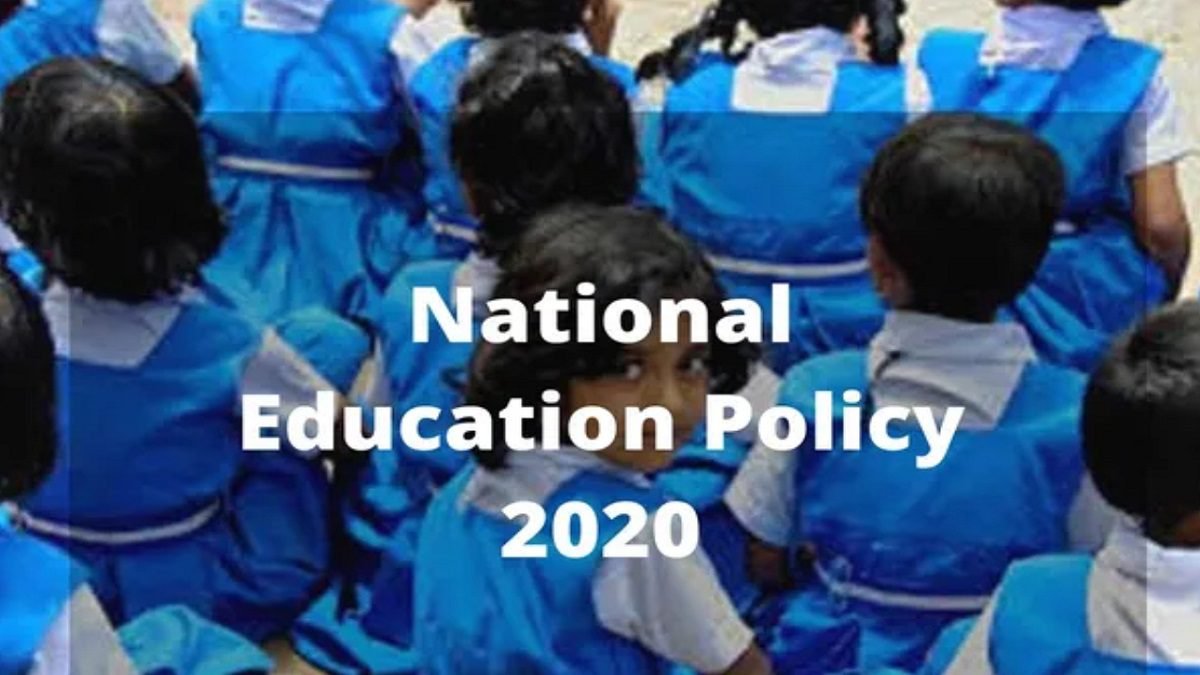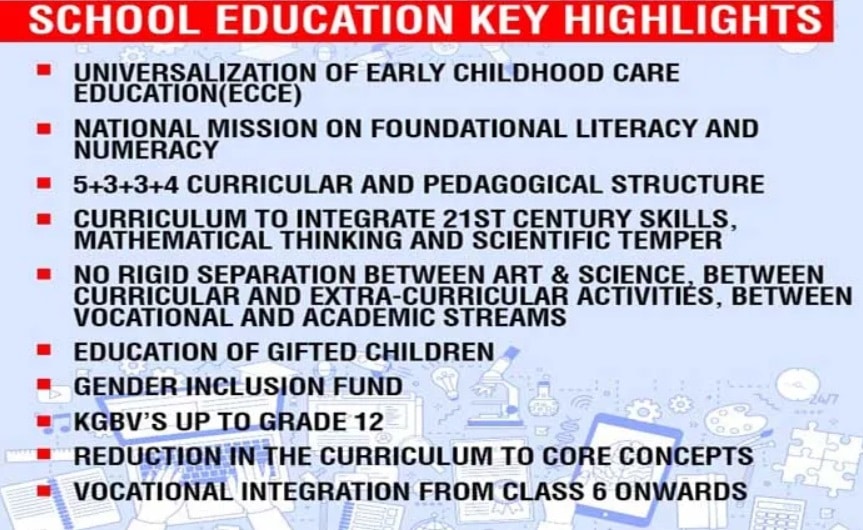MHRD New National Education Policy (NEP) 2020 PDF
Published on sarkariyojana.com

Cabinet Committee of Central government has finally approved MHRD (Now Ministry of Education) New National Education Policy 2020. This new policy will pave the way for transformational reforms in school and higher education in the country. New Policy aims for Universalization of education from pre-school to secondary level with 100% GER in school education by 2030. NEP 2020 will bring 2 crore out of school children back into the main stream. A new 5+3+3+4 school curriculum with 12 years of schooling and 3 years of Anganwadi/ Pre-schooling has been introduced. People can now check latest news about education here and can perform New National Education Policy (NEP) 2020 PDF Download Online.
There would be emphasis on foundational literacy and numeracy, no rigid separation between academic streams, extracurricular, vocational streams in schools. The vocational education will start from Class 6 with internships in the New National Education Policy 2020 (NEP-2020). Teaching upto at least Grade 5 to be in mother tongue/ regional language. Assessment reforms with 360 degree Holistic Progress Card, tracking Student Progress for achieving Learning Outcomes. GER in higher education to be raised to 50% by 2035 and 3.5 crore seats to be added in higher education.
Higher Education curriculum to have Flexibility of Subjects and multiple entry / exit to be allowed with appropriate certification. Academic Bank of Credits to be established to facilitate Transfer of Credits. National Research Foundation to be established to foster a strong research culture. Light but Tight Regulation of Higher Education, single regulator with four separate verticals for different functions.
New National Education Policy (NEP) 2020 PDF Download Online
In the New National Education Policy (NEP) 2020, affiliation system to be phased out in 15 years with graded autonomy to colleges. NEP 2020 advocates increased use of technology with equity and National Educational Technology Forum to be created. NEP 2020 emphasizes setting up of Gender Inclusion Fund, Special Education Zones for disadvantaged regions and groups. New Policy promotes Multilingualism in both schools and HEs. National Institute for Pali, Persian and Prakrit , Indian Institute of Translation and Interpretation to be set up. Ministry of Human Resource Development would henceforth be referred to as the Ministry of Education. Check out complete details here.
NEP 2020 for School Education – Key Highlights
From School Education to Higher Education, the NEP envisions to provide a new structure to the education sector of the country. The important features and highlights of NEP 2020 for School Education are as follows:-
- Existing 10+2 Structure to be modified to 5+3+3+4 structure. The structure would cover ages of 3 to 18 years of age.
Foundational State of 3 and 2 years would include play school and Grades 1 and 2, Preparatory Stages of Grade 3 to 5, Middle School of Grades 6 to 8 and Secondary Stage of Grades 9 to 12. The complete structure has been explained in detail here:-- Foundational Stage (5): For ages 3 to 8 years, the foundational stage has been suggested. The multi-level play activity based learning would include 3 years at anganwadi’s, pre-school or as commonly called play schools and the kindergarten classes catering to ages 3 to 6. In addition to this, the grades 1 and 2 or classes 1 and 2 for students of ages 6 to 8 would also be added. Thus 3 years of pre-school to KG and 2 years of Class 1st & 2nd would total it to 5 years of education. The focus would be on development of language skills and teaching by play based and activity based curriculum.
- Preparatory Stage (3): This is for ages 8 to 11 or classes 3 to 5. The focus would shift to play, discovery and activity based and interaction classroom learning. The focus till this stage would remain on development of language and numeracy skills, in accordance with the cognitive development of a child. Medium of instruction till Grade 5 would be home language or mother tongue or local language. Three languages would be taught to all students – and states would decide which ones.
- Middle Stage (3): Referring to the classes 6 to 8, the new structure aims at transforming the pedagogy from the existing system to a more experiential learning in the sciences, mathematics, arts, social sciences and humanities. Focus would be on critical learning objectives and not on rote learning.
- Secondary Stage (4): This includes classes 9 to 12 or the secondary and the higher secondary as we know them today. The changes suggested at this stage include a multidisciplinary study where students would be able to pick and choose any set of subjects from the available structure. The focus would be on greater critical thinking and flexibility, allowing the child to pick subjects as per their interests – even technical and arts.
- Emphasis on Early Childhood Care and Education or ECCE for ages 3 to 6 where provisions would be made to ensure universal access to high qualify ECCE across the country in phased manner.
- 4 years for higher secondary gets lift up – Arts, Commerce, Science removed – Students to choose what they want to choose. Coding to begin from Class 6. Music, Arts, Sports, would be at the same level. Students will be given increased flexibility and choice of subjects to study, particularly in secondary school – including subjects in physical education, the arts and crafts, and vocational skills.
- Early childhood care and education to get a complete National mission on Foundational Literacy and Numeracy to be set up to focus on foundational literacy.
- Indian Knowledge Systems, Languages, Culture and Values to be given focus. Furthermore, Technology would be used extensively. E-Content in Regional Languages would be developed and not only in Hindi and Englis. School sto be digitally equipped. National Educational Technology Forum, NETF would be formed.
- All State/UT governments will prepare an implementation plan for attaining universal foundational literacy and numeracy in all primary schools for all learners by grade 3 to be achieved by 2025.
- NIOS and State Open Schools will also offer A, B and C levels that are equivalent to Grades 3, 5, and 8 of the formal school system; secondary education programs that are equivalent to Grades 10 and 12; vocational education courses/programs; and adult literacy and life-enrichment programs.
- Curriculum content will be reduced in each subject to its core essentials – key concepts, ideas, applications and problem solving. Emphasis on critical thinking and more holistic, inquiry-based, discovery-based, discussion-based, and analysis-based learning.
- The three-language learned by children will be the choices of States, regions, and of the students, so long as at least two of the three languages are native to India.
NEP also proposes a considerable change in the examination structure. Key stage assessments (at Grades 3, 5 and 8) would be conducted to track the development of the child. As for the secondary stage, the board examinations would be reformed. They would be made easier where students would be tested on the core capabilities. Instead of just one board, a more modular model to be explored and is expected to be in place by 2022-23.
National Education Policy 2020 PDF
The new final MHRD national education policy 2020 PDF with highlights can be downloaded from the following links in Hindi and English. The complete education policy 2020 document is now available to download from MHRD website. However, the National education policy 2020 is built on the basis of Draft of National Education Policy 2019 which was released in May last year and can be downloaded from the official website of MHRD in Hindi and English using the links below.
Draft National Education Policy 2019 PDF – English
प्रारूप (Draft) राष्ट्रीय शिक्षा नीति PDF 2019 हिन्दी में
NEP 2020 PDF (Final) – Click Here
New National Education Policy 2020: Higher Education Key Highlights
Here are the important features and highlights of New National Education Policy 2020:-
- Regulatory System of Higher Education to be distinct for regulation, accreditation, funding and academic standard setting – all under the umbrella of Higher Education Commission of India or HECI.
- 4 Verticals of HECI to be National Higher Education Regulatory Council or HNERC, National Accreditation Council (NAC), Higher Education Grants Council (HEGC) and General Education Council (GEC) which would further form a National Higher Education Qualification Framework.
- UGC, AICTE to be replaced by a single Higher Education Regulator – HECI.
- The professional councils, such as the Indian Council for Agricultural Research (ICAR), Veterinary Council of India (VCI), National Council for Teacher Education (NCTE), Council of Architecture (CoA), National Council for Vocational Education and Training (NCVET) etc., will act as Professional Standard Setting Bodies (PSSBs).
- Universities to be named not on the basis of ownership but on quality of education.
- Impetus to multidisciplinary education. Even IITs to move towards a more holistic curriculum with arts and humanities.
- The undergraduate degree will be of either 3 or 4-year duration, with multiple exit options within this period, with appropriate certifications, e.g., a certificate after completing 1 year in a discipline or field including vocational and professional areas, or a diploma after 2 years of study, or a Bachelor’s degree after a 3-year programme. The 4-year multidisciplinary Bachelor’s programme, however, shall be the preferred option.
- Students pursuing 4 year degree programme would have an option of getting a degree with Research if the research process is completed in the are of study as specified.
- National Research Foundation would be set up with a goal to enable ‘a culture of research’. NRF would be governed independently by rotating board of governors. Primary task or NRF would be to fund competitive, peer reviewed grant proposals of all types and across all disciplines and also act as a liasion between researchers and relevant branches of government so as to allow breakthroughs.
Major reforms suggested in the higher education to give more flexibility to the students. Students can choose any set of subjects for higher education, take sabbatical and other options.

NEP Draft was presented in 2019 where it quickly received both appreciation as well as strong criticism. The suggestion of making Hindi one of the compulsory languages was soon shot down by many. The draft was then put in public domain and suggestions invited from the people and all stakeholders regarding the policy. MHRD had received lakhs of suggestions and the NEP draft was accordingly modified.
